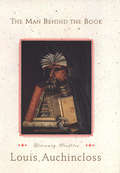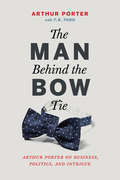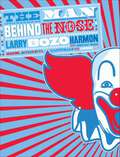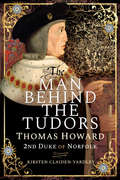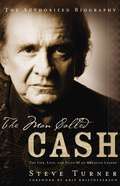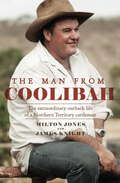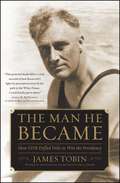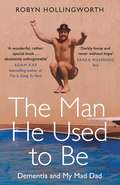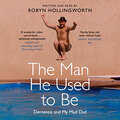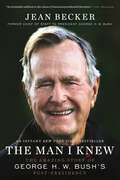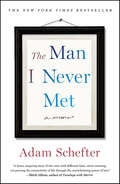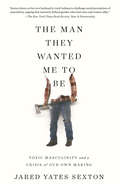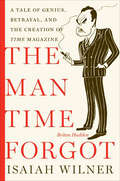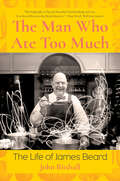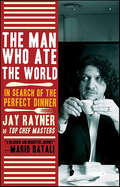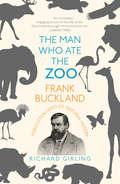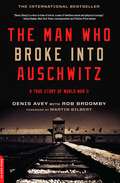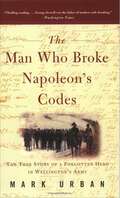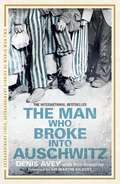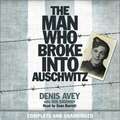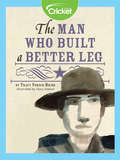- Table View
- List View
The Man Behind the Book: Literary Profiles
by Louis AuchinclossInformation about the following authors: CYRIL TOURNEUR, PROSPER MERIMEE, ANNE BRONTE, DUMAS fils, LORD BRYCE, WALTER PATER, JOHN WALTER CROSS, HENRY JAMES, SARAH ORNE JEWETT, ROBERT GRANT, THE ABBE MUGNIER, F. MARION CRAWFORD, HAROLD FREDERIC, PAUL HERVIEU, ROBERT HERRICK, AMY LOWELL, L. COMPTON-BURNETT, ELINOR WYLIE, HAROLD NICOLSON, MAXWELL ANDERSON, S. N. BEHRMAN, ROBERT E. SHERWOOD and Iris Origo.
The Man Behind the Book: Literary Profiles
by Louis AuchinclossTwenty-three biographical essays on writers admired by the National Medal of Arts–winning author of The Education of Oscar Fairfax.For Louis Auchincloss, life and letters are not two things but one. It therefore comes as no surprise that when he writes about writers, their lives are considered as closely as their works. He takes what today is a refreshingly unpopular position: that the artist and his art cannot be teased apart, that biography of criticism and criticism biography. For Mr. Auchincloss, it all boils down to that maxim of Buffon’s: “the style’s the man,” the man behind the book.The twenty-three writers discussed here are a mixed lot—English, American, and French; novelists, poets, and playwrights; Jacobeans, Victorians, and moderns—yet each has meant a great deal to Mr. Auchincloss as a reader and a writer. Some of them are classics, and familiar Auchincloss subjects: Sarah Orne Jewett, Henry James, Ivy Compton-Burnett. Others, among them Prosper Merimee, Harold Frederic, and Amy Lowell, were famous once but are now obscure. In their cases it is Mr. Auchincloss’s self-described task “to explore the reasons for their fall from grace,” reasons that prove to be unfailingly personal as well as artistic. But as Mr. Auchincloss would rather praise and share than damn and dismiss, it is also his task “to seek the portions of their work that may still merit attention.”Alfred Kazin once noted that Mr. Auchincloss’s essays are marked by “perfect literary grace and wit.” These qualities have never been so evident as in this volume, an informal study of some of the author's favorite books and the fascinating artists behind them.
The Man Behind the Bow Tie
by Arthur Porter T. R. ToddHow does it feel to be deemed guilty before trial? To be held in a cutthroat Panamanian prison while suffering from terminal lung cancer? How does it feel to rise to the top of the medical and public arenas in your adopted country, only to crash miserably to earth under allegations of fraud and money laundering? In short: What is it like to be Dr. Arthur Porter? There are few contemporary figures in Canada more intriguing and controversial than the former spy watchdog of the Canadian Security Intelligence Service. A physician by trade, Porter, always in his iconic bow tie, has been described as intelligent, charismatic, and relentless in his ambitions. Others have called him deceitful, manipulative, and unscrupulous.
The Man Behind the Nose: Assassins, Astronauts, Cannibals, and Other Stupendous Yarns
by Larry HarmonThe Man Behind the Nose is the autobiography of the man who was Bozo. For 50 years Larry Harmon was the face—and the nose—of Bozo the Clown, the most well-known, beloved clown of them all, the precursor for every successful modern-day harlequin to come, from Ronald McDonald to Krusty. A warm, surprising, and endlessly entertaining life story filled to the brim with “Assassins, Astronauts, Cannibals, and Other Stupendous Tales,” The Man Behind the Nose is a rollicking ride through the world of a true American icon in greasepaint.
The Man Behind the Tudors: Thomas Howard, 2nd Duke of Norfolk
by Kirsten Claiden-Yardley“Shed[s] some light on a rather remarkable man who was really behind the curtain during the reigns of quite a few English kings.” —Adventures of a Tudor NerdThomas Howard, 2nd duke of Norfolk, lived a remarkable life spanning eighty years and the reigns of six kings. Amongst his descendants are his granddaughters, Anne Boleyn and Catherine Howard, and his great-granddaughter, Elizabeth I. The foundations of this dramatic and influential dynasty rest on Thomas’ shoulders, and it was his career that placed the Howard family in a prominent position in English society and at the Tudor royal court.Thomas was born into a fairly ordinary gentry family, albeit distantly related to the Mowbray dukes of Norfolk. During the course of the fifteenth century, he and his father would rise through the political and social ranks as a result of their loyal service to Edward IV and Richard III. In a tragic turn of events, all their hard work was undone at the Battle of Bosworth and his father was killed fighting for King Richard. Imprisoned for treason and stripped of his lands and titles, Thomas had to start from the beginning to gain the trust of a new king. He spent the next thirty-five years devoting his administrative, military and diplomatic skills to the Tudors whilst rebuilding his family fortunes and ensuring that his numerous children were well-placed to prosper.“The Howards are one of the most intriguing families of the 16th century and this book opens up a chapter that hasn’t been much written about.” —The Tudor Blogger
The Man Called CASH: The Life, Love and Faith of an American Legend
by Steve TurnerJohnny Cash is one of the most influential figures in music and American popular culture today. While he was an icon to people of all ages during his life, Cash's legacy continues after his death. His remarkable story is captured in this exclusive authorized biography, addressing the whole life of Johnny Cash-not just his unforgettable music but also his relationship with June Carter Cash and his faith in Christ. His authenticity, love for God and family, and unassuming persona are what Steve Turner captures with passion and focus in this inspiring book. Different from other books written about him, The Man Called CASH brings Cash's faith and love for God into the foreground and tells the story of a man redeemed, without watering-down or sugar-coating. Unquestionably one of the biggest book releases of 2004, The Man Called CASH will be a huge success with his millions of fans and will draw in many new fans with this inspiring story of faith and redemption.The audio book, ISBN 084996377X, is narrated by Cash's close friend and musical partner, Kris Kristofferson.
The Man From Coolibah
by James Knight Milton JonesIn the tradition of Mailman of the Birdsville Track, The Man from Coolibah details the life of outback cattle property owner, helicopter muster operator and knockabout bloke Milton Jones.The youngest in a family of five, Milton Jones grew up on large properties in the outback. His father was a farm manager and so his early life was a world away from that of city kids. Milton left school in Queensland in his mid teens and moved back to the Northern Territory. Mustering was in his blood and so his first job was as a bullcatcher.Milton Jones is a man of his environment; tough and hardworking with a firm opinion on most things that he isn?t afraid to share. The story of how he bought Coolibah Station in 1988 in cash and the way he has built up his country empire is just one element of this book. For him, wrangling crocs, mustering cattle, fighting bush fires and riding rodeo are the norm. Over 500 km away from nearest city, Darwin, his life is lived on horseback, his days ruled by the sunlight. With the help of a seasonal workforce, plus his 42 choppers and a dozen or so horses, his business musters cattle from across the territory.The Man from Coolibah shows us what it is like to live in the never never and brings the Outback to life. For the men and women who live in Milton?s world, things are changing but the harshness and beauty of the outback stays the same.
The Man He Became
by James TobinWith a searching new analysis of primary sources, NBCC award winner James Tobin reveals how FDR's fight against polio transformed him from a callow aristocrat into the energetic, determined statesman who would rally the nation in the Great Depression and lead it through World War II.When polio paralyzed Franklin Roosevelt at thirty-nine, people wept to think that the young man of golden promise must live out his days as a helpless invalid. He never again walked on his own. But in just over a decade, he had regained his strength and seized the presidency. This was the most remarkable comeback in the history of American politics. And, as author James Tobin shows, it was the pivot of Roosevelt's life--the triumphant struggle that tempered and revealed his true character. With enormous ambition, canny resourcefulness, and sheer grit, FDR willed himself back into contention and turned personal disaster to his political advantage. Tobin's dramatic account of Roosevelt's ordeal and victory offers central insights into the forging of one of our greatest presidents.
The Man He Used To Be: Dementia and My Mad Dad
by Robyn Hollingworth'This is a wonderful, rather special book: funny, warm and loving but also thought-provoking and deeply moving. Absolutely unforgettable - ironically.'ADAM KAY, Sunday Times bestselling author of This Is Going To HurtInadvertent cross-dressing. Attempted murder. Jail break. A waltz at a funeral. A hernia the size of Guernsey.Heartbreaking and darkly comic, these are the moments that litter the messy road from cared-for to carer, a journey that Robyn Hollingworth finds herself on when she's only twenty-five years old. Leaving London to return home to rural South Wales, Robyn finds that it's her old life - same teddy bears resting on her pillow, their bodies tucked under the duvet; same view of the garages behind which she'd had her first cigarette and first kiss - but so much has changed. Her dad, the proud, charmingly intelligent, self-made man who made people laugh, is in the grip of early onset Alzheimer's. His brilliant mind, which saw him building power stations and literally bringing light into the lives of others, has succumbed to darkness. As Robyn settles back in the rhythms of life in the rain-soaked vast Welsh valleys, she keeps a diary charting her journey as the dad she knew disappears before her eyes. Lyrical, poignant and with flashes of brilliant humour, The Man He Used To Be explores how in helping others we can heal ourselves. Previously published in hardback as My Mad Dad.
The Man He Used To Be: Dementia and My Mad Dad
by Robyn Hollingworth'This is a wonderful, rather special book: funny, warm and loving but also thought-provoking and deeply moving. Absolutely unforgettable - ironically.' ADAM KAY, Sunday Times bestselling author of This Is Going To HurtInadvertent cross-dressing. Attempted murder. Jail break. A waltz at a funeral. A hernia the size of Guernsey.Heartbreaking and darkly comic, these are the moments that litter the messy road from cared-for to carer, a journey that Robyn Hollingworth finds herself on when she's only twenty-five years old. Leaving London to return home to rural South Wales, Robyn finds that it's her old life - same teddy bears resting on her pillow, their bodies tucked under the duvet; same view of the garages behind which she'd had her first cigarette and first kiss - but so much has changed. Her dad, the proud, charmingly intelligent, self-made man who made people laugh, is in the grip of early onset Alzheimer's. His brilliant mind, which saw him building power stations and literally bringing light into the lives of others, has succumbed to darkness. As Robyn settles back in the rhythms of life in the rain-soaked vast Welsh valleys, she keeps a diary charting her journey as the dad she knew disappears before her eyes. Lyrical, poignant and with flashes of brilliant humour, The Man He Used To Be explores how in helping others we can heal ourselves. Previously published in hardback as My Mad Dad.
The Man I Knew: The Amazing Story of George H. W. Bush's Post-Presidency
by Jean BeckerA heartfelt portrait of President George H.W. Bush—and his post-presidential life—by the confidante who knew him best. <P><P><b>A New York Times Best Seller</b>
The Man I Never Met: A Memoir
by Adam SchefterA powerful true story of loss and hope by one of the biggest names in sports media, Adam Schefter's The Man I Never Met.On September 11, 2001, Joe Maio went to work in the north tower of the World Trade Center. He never returned, leaving behind a wife, Sharri, and 15-month old son, Devon. Five years later, Sharri remarried, and Devon welcomed a new dad into his life.For thousands, the whole country really, 9/11 is a day of grief. For Adam and Sharri Maio Schefter and their family it’s not just a day of grief, but also hope. This is a story of 9/11, but it’s also the story of 9/12 and all the days after. Life moved on. Pieces were picked up. New dreams were dreamed. The Schefters are the embodiment of that.The Man I Never Met will give voice to all those who have chosen to keep living. It’s gratifying and beautiful. But also messy and hard. Like most families. Except that one day every year history comes roaring back. How do you embrace that? How do you honor that? This book is also a peek at Adam Schefter ("Schefty"), the man behind the headlines and injury reports; a real person who has a real family. It will follow in the path of other ESPN books by Tom Rinaldi and the late Stuart Scott – books that have transcended sport to examine the raw emotion of life.
The Man That Got Away: The Life and Songs of Harold Arlen (Music in American Life)
by Walter RimlerOver the Rainbow, "Stormy Weather," and "One for My Baby" are just a few of Harold Arlen's well-loved compositions. Yet his name is hardly known--except to the musicians who venerate him. At a gathering of songwriters George Gershwin called him "the best of us." Irving Berlin agreed. Paul McCartney sent him a fan letter and became his publisher. Bob Dylan wrote of his fascination with Arlen's "bittersweet, lonely world." A cantor's son, Arlen believed his music was from a place outside himself, a place that also sent tragedy. When his wife became mentally ill and was institutionalized he turned to alcohol. It nearly killed him. But the beautiful songs kept coming: "Blues in the Night," "My Shining Hour," "Come Rain or Come Shine," and "The Man That Got Away." Walter Rimler drew on interviews with friends and associates of Arlen and on newly available archives to write this intimate portrait of a genius whose work is a pillar of the Great American Songbook.
The Man They Wanted Me to Be: Toxic Masculinity and a Crisis of Our Own Making
by Jared Yates SextonBased on the provocative and popular New York Times op–ed, this memoir alternates between the examination of a working–class upbringing and a cultural analysis of the historical, psychological, and sociological sources that make up the roots of toxic masculinity and its impact on society.As progressivism changes American society, and globalism shifts labor away from traditional manufacturing, the roles that have been prescribed to men since the Industrial Revolution have been rendered obsolete. Donald Trump's campaign successfully leveraged male resentment and entitlement, and now, with Trump as president and the rise of the #MeToo movement, it’s clear that our current definitions of masculinity are outdated and even dangerous.Deeply personal and thoroughly researched, the author of The People Are Going to Rise Like the Waters Upon Your Shore has turned his keen eye to our current crisis of masculinity using his upbringing in rural Indiana to examine the personal and societal dangers of the patriarchy. The Man They Wanted Me to Be examines how we teach boys what’s expected of men in America, and the long–term effects of that socialization―which include depression, shorter lives, misogyny, and suicide. Sexton turns his keen eye to the establishment of the racist patriarchal structure which has favored white men, and investigates the personal and societal dangers of such outdated definitions of manhood."By carefully and soberly examining his own story, Sexton deconstructs American life and gives many examples of how pervasive toxic masculinity is in our culture." ―Henry Rollins, Los Angeles Times"This book is critically important to our historical moment . . . Crackles with intensity and absolutely refuses to allow the reader to look away for even a moment from the blight that toxic masculinity in America has wrought." ―Nicholas Cannariato, NPR
The Man Time Forgot: A Tale of Genius, Betrayal, and the Creation of Time Magazine
by Isaiah WilnerAn “illuminating biography” of the forgotten, tragic genius who founded Time magazine with his friend and fierce rival Henry Luce (The New Yorker).Friends, collaborators, and childhood rivals, Briton Hadden and Henry R. Luce were not yet twenty-five when they started Time, the first newsmagazine, at the outset of the Roaring Twenties. By age thirty, they were both millionaires, having laid the foundation for a media empire. But their partnership was explosive and their competition ferocious, fueled by envy as well as love. When Hadden died at the age of thirty-one, Luce began to meticulously bury the legacy of the giant he was never able to best.In this groundbreaking, stylish, and passionate biography, Isaiah Wilner paints a fascinating portrait of Briton Hadden—genius and visionary—and presents the first full account of the birth of Time, while offering a provocative reappraisal of Henry R. Luce, arguably the most significant media figure of the twentieth century.“A riveting narrative . . . richly detailed . . . part This Side of Paradise, part Citizen Kane.” —The Wall Street Journal“[A] scintillating biography . . . a perceptive psychological study and cultural history, with a touch of ink-stained romanticism.” —Publishers Weekly“With access to the Time archives and unpublished interviews and correspondence, Wilner offers all the excitement of a new media enterprise launched in the Roaring Twenties by two fascinating figures.” —Booklist
The Man Who Ate Too Much: The Life Of James Beard
by John BirdsallThe definitive biography of America’s best-known and least-understood food personality, and the modern culinary landscape he shaped. In the first portrait of James Beard in twenty-five years, John Birdsall accomplishes what no prior telling of Beard’s life and work has done: He looks beyond the public image of the "Dean of American Cookery" to give voice to the gourmet’s complex, queer life and, in the process, illuminates the history of American food in the twentieth century. At a time when stuffy French restaurants and soulless Continental cuisine prevailed, Beard invented something strange and new: the notion of an American cuisine. Informed by previously overlooked correspondence, years of archival research, and a close reading of everything Beard wrote, this majestic biography traces the emergence of personality in American food while reckoning with the outwardly gregarious Beard’s own need for love and connection, arguing that Beard turned an unapologetic pursuit of pleasure into a new model for food authors and experts. Born in Portland, Oregon, in 1903, Beard would journey from the pristine Pacific Coast to New York’s Greenwich Village by way of gay undergrounds in London and Paris of the 1920s. The failed actor–turned–Manhattan canapé hawker–turned–author and cooking teacher was the jovial bachelor uncle presiding over America’s kitchens for nearly four decades. In the 1940s he hosted one of the first television cooking shows, and by flouting the rules of publishing would end up crafting some of the most expressive cookbooks of the twentieth century, with recipes and stories that laid the groundwork for how we cook and eat today. In stirring, novelistic detail, The Man Who Ate Too Much brings to life a towering figure, a man who still represents the best in eating and yet has never been fully understood—until now. This is biography of the highest order, a book about the rise of America’s food written by the celebrated writer who fills in Beard’s life with the color and meaning earlier generations were afraid to examine.
The Man Who Ate the World: In Search of the Perfect Dinner
by Jay RaynerAn astronomical gastronomical undertaking —one of the world's preeminent restaurant critics takes on the giants of haute cuisine, one tasting menu at a timeLike the luxury fashion companies Gucci and Chanel, high-end dining has gone global, and Jay Rayner has watched, amazed, as the great names of the restaurant business have turned themselves from artisans into international brands.Long suspecting that his job was too good to be true, Rayner uses his entrée into this world to probe the larger issues behind the globalization of dinner. Combining memoir with vivid scenes at the table; interviews with the world's most renowned chefs, restaurateurs, and eaters; and a few well-placed rants and raves about life as a paid gourmand, Rayner puts his thoughtful, innovative, and hilarious stamp on food writing. He reports on high-end gastronomy from Vegas to Dubai, Moscow to Tokyo, London to New York, ending in Paris where he attempts to do with Michelin-starred restaurants what Morgan Spurlock did with McDonald's in Super Size Me—eating at those establishments on consecutive days and never refusing a sixteen-course tasting menu when it's offered.The Man Who Ate the World is a fascinating and riotous look at the business and pleasure of fine dining.
The Man Who Ate the Zoo: Frank Buckland, forgotten hero of natural history
by Richard GirlingFrank Buckland was an extraordinary man – surgeon, natural historian, popular lecturer, bestselling writer, museum curator, and a conservationist before the concept even existed. Eccentric, revolutionary, prolific, he was one of the nineteenth century’s most improbable geniuses. His lifelong passion was to discover new ways to feed the hungry. Rhinoceros, crocodile, puppy-dog, giraffe, kangaroo, bear and panther all had their chance to impress, but what finally - and, eventually, fatally - obsessed him was fish. Forgotten now, he was one of the most original, far-sighted and influential natural scientists of his time, held as high in public esteem as his great philosophical enemy, Charles Darwin.
The Man Who Broke Into Auschwitz: A True Story of World War II
by Denis Avey Rob BroombyThe Man Who Broke into Auschwitz is the extraordinary true story of a British soldier who marched willingly into the concentration camp, Buna-Monowitz, known as Auschwitz III. In the summer of 1944, Denis Avey was being held in a British POW labour camp, E715, near Auschwitz III. He had heard of the brutality meted out to the prisoners there and he was determined to witness what he could. He hatched a plan to swap places with a Jewish inmate and smuggled himself into his sector of the camp. He spent the night there on two occasions and experienced at first-hand the cruelty of a place where slave workers, had been sentenced to death through labor. Astonishingly, he survived to witness the aftermath of the Death March where thousands of prisoners were murdered by the Nazis as the Soviet Army advanced. After his own long trek right across central Europe he was repatriated to Britain. For decades he couldn't bring himself to revisit the past that haunted his dreams, but now Denis Avey feels able to tell the full story--a tale as gripping as it is moving--which offers us a unique insight into the mind of an ordinary man whose moral and physical courage are almost beyond belief.
The Man Who Broke Napoleon's Codes: The True Story of a Forgotten Hero in Wellington's Army
by Mark UrbanThe little-known story of a brilliant British code-cracker: &“[Urban] has pieced together the fragments and deciphered the truth about a hidden hero.&” —Daily Telegraph The Duke of Wellington—who began his military career as Arthur Wellesley—is rightly credited for the strategic and intelligence-gathering brilliance that culminated in Britain&’s defeat of Napoleon at Waterloo. Two centuries later, many of his subordinates are still remembered for their roles in these historic campaigns. But Lt. Col. George Scovell is not among them. This is the story of a man of common birth—bound, according to the severe social strictures of eighteenth-century England, for the life of a tradesman—who would become his era&’s most brilliant code-breaker and an officer in Wellesley&’s army. In an age when officers were drawn almost exclusively from the ranks of the nobility, George Scovell—an engraver&’s apprentice—joined Wellesley in 1809. Scovell provides a fascinating lens through which to view a critical era in military history—his treacherous rise through the ranks despite the scorn of his social betters, and his presence alongside Wellesley in each of the major European campaigns from the Iberian Peninsula through Waterloo. But Scovell was more than just a participant in those events. Already recognized as a gifted linguist, Scovell would prove a remarkably nimble cryptographer. Encoded communiqués between Napoleon and his generals, intercepted by the British, were brought to Scovell for his skilled deciphering. As Napoleon&’s encryption techniques became more sophisticated, Wellesley came to rely ever more on Scovell&’s genius for this critical intelligence. In Scovell&’s lifetime, his role in Britain&’s greatest military victory was grudgingly acknowledged, but his accomplishments would eventually be credited to others—including Wellington himself. His name—and contributions—have been largely overlooked.The Man Who Broke Napoleon&’s Codes tells the fascinating story of the early days of cryptology, re-creates the high drama of some of Europe&’s most remarkable military campaigns, and restores the mantle of hero to a man heretofore forgotten by history. &“Combine[s] the fast-paced narrative of a spy novel with colorful period detail describing the inner workings of an army staff at war.&” —Library Journal &“Thrilling reading.&” —The Washington Times
The Man Who Broke into Auschwitz: The Extraordinary True Story (Extraordinary Lives, Ext Ser.)
by Denis Avey Rob BroombyTHE INTERNATIONAL BESTSELLERTHE MAN WHO BROKE INTO AUSCHWITZ is the extraordinary true story of a British soldier who marched willingly into Buna-Monowitz, the concentration camp known as Auschwitz III.In the summer of 1944, Denis Avey was being held in a POW labour camp, E715, near Auschwitz III. He had heard of the brutality meted out to the prisoners there and he was determined to witness what he could. He hatched a plan to swap places with a Jewish inmate and smuggled himself into his sector of the camp. He spent the night there on two occasions and experienced at first-hand the cruelty of a place where slave workers, had been sentenced to death through labour. Astonishingly, he survived to witness the aftermath of the Death March where thousands of prisoners were murdered by the Nazis as the Soviet Army advanced. After his own long trek right across central Europe he was repatriated to Britain. For decades he couldn't bring himself to revisit the past, but now Denis Avey feels able to tell the full story - a tale as gripping as it is moving - which offers us a unique insight into the mind of an ordinary man whose moral and physical courage are almost beyond belief.
The Man Who Broke into Auschwitz: The Extraordinary True Story (Extraordinary Lives, Extraordinary Stories of World War Two #8)
by Denis Avey Rob BroombyTHE INTERNATIONAL BESTSELLERTHE MAN WHO BROKE INTO AUSCHWITZ is the extraordinary true story of a British soldier who marched willingly into Buna-Monowitz, the concentration camp known as Auschwitz III.In the summer of 1944, Denis Avey was being held in a POW labour camp, E715, near Auschwitz III. He had heard of the brutality meted out to the prisoners there and he was determined to witness what he could. He hatched a plan to swap places with a Jewish inmate and smuggled himself into his sector of the camp. He spent the night there on two occasions and experienced at first-hand the cruelty of a place where slave workers, had been sentenced to death through labour. Astonishingly, he survived to witness the aftermath of the Death March where thousands of prisoners were murdered by the Nazis as the Soviet Army advanced. After his own long trek right across central Europe he was repatriated to Britain. For decades he couldn't bring himself to revisit the past, but now Denis Avey feels able to tell the full story - a tale as gripping as it is moving - which offers us a unique insight into the mind of an ordinary man whose moral and physical courage are almost beyond belief.
The Man Who Broke into Auschwitz: The Extraordinary True Story (Extraordinary Lives, Extraordinary Stories of World War Two #8)
by Denis Avey Rob BroombyTHE MAN WHO BROKE INTO AUSCHWITZ is the extraordinary true story of a British soldier who marched willingly into Buna-Monowitz, the concentration camp known as Auschwitz III.In the summer of 1944, Denis Avey was being held in a POW labour camp, E715, near Auschwitz III. He had heard of the brutality meted out to the prisoners there and he was determined to witness what he could. He hatched a plan to swap places with a Jewish inmate and smuggled himself into his sector of the camp. He spent the night there on two occasions and experienced at first-hand the cruelty of a place where slave workers, had been sentenced to death through labour. Astonishingly, he survived to witness the aftermath of the Death March where thousands of prisoners were murdered by the Nazis as the Soviet Army advanced. After his own long trek right across central Europe he was repatriated to Britain. For decades he couldn't bring himself to revisit the past that haunted his dreams, but now Denis Avey feels able to tell the full story - a tale as gripping as it is moving - which offers us a unique insight into the mind of an ordinary man whose moral and physical courage are almost beyond belief. (P)2011 Hodder & Stoughton
The Man Who Built a Better Leg
by Tracy Vonder BrinkInjured by a cannonball, James Edward Hanger was the first amputee of the Civil War. Determined to find a better solution than a peg leg, he worked to develop his own artificial limb company. He even continued working past retirement, providing Hanger Limbs for victims of World War I.

